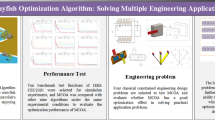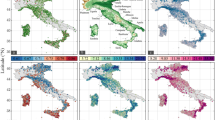Abstract
An integrated approach of system dynamics (SD), orthogonal experimental design (OED) and inexact optimization modeling was proposed for water resources management under uncertainty. The developed method adopted a combination of SD and OED to identify key scenarios within multiple factors, through which interval solutions for water demands could be obtained as input data for consequential optimization modeling. Also, optimal schemes could be obtained in the combination of inexact two-stage stochastic programming and credibility constrained programming. The developed method was applied to a real-world case study for supporting allocation of multiple-source water resources to multiple users in Dalian city within a multi-year context. The results indicated that a lower credibility-satisfaction level would generate higher allocation efficiency, a higher system benefit and a lower system violation risk. The developed model could successfully reflect and address the variety of uncertainties through provision of credibility levels, which corresponds to the decision makers’ preference regarding the tradeoffs between system benefits and violation risks.











Similar content being viewed by others

References
Birge JR, Louveaux FV (1988) A multicut algorithm for two-stage stochastic linear programs. Eur J Oper Res 34(3):384–392. doi:10.1016/0377-2217(88)90159-2
Cai YP, Huang GH, Nie XH, Li YP, Tan Q (2007) Municipal solid waste management under uncertainty: a mixed interval parameter fuzzy-stochastic robust programming approach. Environ Eng Sci 24(3):338–352. doi:10.1089/ees.2005.0140
Cai YP, Huang GH, Tan Q, Liu L (2011) An integrated approach for climate-change impact analysis and adaptation planning under multi-level uncertainties. Part II Case study Renew Sustain Energ Rev 15(6):3051–3073. doi:10.1016/j.rser.2011.03.014
Dong C, Tan Q, Huang GH, Cai YP (2014) A dual-inexact fuzzy stochastic model for water resources management and non-point source pollution mitigation under multiple uncertainties. Hydrol Earth Syst Sci 18(5):1793–1803. doi:10.5194/hess-18-1793-2014
Guo P, Huang GH, Zhu H, Wang XL (2010) A two-stage programming approach for water resources management under randomness and fuzziness. Environ Model Softw 25(12):1573–1581. doi:10.1016/j.envsoft.2010.04.018
Han Y, Huang YF, Wang GQ, Maqsood I (2011) A multi-objective linear programming model with interval parameters for water resources allocation in Dalian city. Water Resour Manag 25(2):449–463. doi:10.1007/s11269-010-9708-7
Huang XX (2006) Credibility-based chance-constrained integer programming models for capital budgeting with fuzzy parameters. Inf Sci 176(18):2698–2712. doi:10.1016/j.ins.2005.11.012
Huang GH, Cao MF (2011) Analysis of solution methods for interval linear programming. J Environ Inf 17(2):54–64
Kitsikoudis V, Spiliotis M, Hrissanthou V (2016) Fuzzy regression analysis for sediment incipient motion under turbulent flow conditions. Environ Process 3(3):663–679. doi:10.1007/s40710-016-0154-2
Leyton A, Pezoa-Conte R, Barriga A, Buschmann AH, Mäki-Arvela P, Mikkola JP, Lienqueo ME (2016) Identification and efficient extraction method of phlorotannins from the brown seaweed Macrocystis pyrifera using an orthogonal experimental design. Algal Res 16:201–208. doi:10.1016/j.algal.2016.03.019
Liu B, Liu YK (2002) Expected value of fuzzy variable and fuzzy expected value models. IEEE T Fuzzy Syst 10(4):445–450
Liu Y, Huang GH, Cai YP, Dong C (2011) An inexact mix-integer two-stage linear programming model for supporting the Management of a Low-Carbon Energy System in China. Energies 4(10):1657–1686. doi:10.3390/en4101657
Lu RS, Lo SL (2002) Diagnosing reservoir water quality using self-organizing maps and fuzzy theory. Water Res 36(9):2265–2274. doi:10.1016/S0043-1354(01)00449-3
de Oliveira RP, Matos JS, Monteiro AJ (2015) Managing the urban water cycle in a changing environment. Water Util J 9:3–12
Rong A, Lahdelma R (2008) Fuzzy chance constrained linear programming model for optimizing the scrap charge in steel production. Eur J Oper Res 186(3):953–964. doi:10.1016/j.ejor.2007.02.017
Sahin O, Stewart RA, Porter MG (2015) Water security through scarcity pricing and reverse osmosis: a system dynamics approach. J Clean Prod 88:160–171. doi:10.1016/j.jclepro.2014.05.009
Sahin O, Siems RS, Stewart RA, Porter MG (2016) Paradigm shift to enhanced water supply planning through augmented grids, scarcity pricing and adaptive factory water: a system dynamics approach. Environ Model Softw 75:348–361. doi:10.1016/j.envsoft.2014.05.018
Tan Q, Huang GH, Cai YP (2013) Multi-source multi-sector sustainable water supply under multiple uncertainties: an inexact fuzzy-stochastic quadratic programming approach. Water Resour Manag 27(2):451–473. doi:10.1007/s11269-012-0196-9
Tang JC, Gong GC, Su H, Wu FH, Herman C (2016) Performance evaluation of a novel method of frost prevention and retardation for air source heat pumps using the orthogonal experiment design method. Appl Energy 169:696–708. doi:10.1016/j.apenergy.2016.02.042
Tsakiris G (2014) Rational design of urban water supply and distribution systems. Water Util J 8:5–16
Tsakiris G, Spiliotis M (2004) Fuzzy linear programming for problems of water allocation under uncertainty. Eur Water 7(8):25–37
Walker WE, Loucks DP, Carr G (2015) Social responses to water management decisions. Environ Process 2(3):485–509. doi:10.1007/s40710-015-0083-5
Wang S, Huang GH (2015) A multi-level Taguchi-factorial two-stage stochastic programming approach for characterization of parameter uncertainties and their interactions: an application to water resources management. Eur J Oper Res 240(2):572–581. doi:10.1016/j.ejor.2014.07.011
Wu G, Li L, Ahmad S, Chen X, Pan X (2013) A dynamic model for vulnerability assessment of regional water resources in arid areas: a case study of Bayingolin, China. Water Resour Manag 27(8):3085–3101. doi:10.1007/s11269-013-0334-z
Xie YL, Huang GH, Li W, Li JB, Li YF (2013) An inexact two-stage stochastic programming model for water resources management in Nansihu Lake Basin, China. J Environ Manag 127:188–205. doi:10.1016/j.jenvman.2013.04.027
Zhang YM, Huang GH (2010) Fuzzy robust credibility-constrained programming for environmental management and planning. J Air Waste Manage Assoc 60(6):711–721. doi:10.3155/1047-3289.60.6.711
Zhao R, Liu B (2005) Standby redundancy optimization problems with fuzzy lifetimes. Comput Ind Eng 49(2):318–338. doi:10.1016/j.cie.2005.03.003
Zhou Y, Guo S, Xu CY, Liu D, Chen L, Ye Y (2015) Integrated optimal allocation model for complex adaptive system of water resources management (I): methodologies. J Hydrol 531 3:964–976. doi:10.1016/j.jhydrol.2015.10.007
Acknowledgements
This work was supported by the National Key R&D Program of China (2016YFC0502209), and the National Natural Science Foundation of China (Nos. 51522901 and 51421065). The authors would also extend the appreciation to the anonymous reviewers and editors for their constructive comments for improving the paper.
Author information
Authors and Affiliations
Corresponding author
Rights and permissions
About this article
Cite this article
Wang, B., Cai, Y., Yin, X. et al. An Integrated Approach of System Dynamics, Orthogonal Experimental Design and Inexact Optimization for Supporting Water Resources Management under Uncertainty. Water Resour Manage 31, 1665–1694 (2017). https://doi.org/10.1007/s11269-017-1608-7
Received:
Accepted:
Published:
Issue Date:
DOI: https://doi.org/10.1007/s11269-017-1608-7



